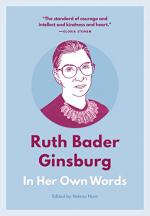
|
| Name: _________________________ | Period: ___________________ |
This test consists of 15 multiple choice questions and 5 short answer questions.
Multiple Choice Questions
1. What is the name Ginsburg was given at birth?
(a) Ruth Bader Ginsburg.
(b) Jill Ruth Bader.
(c) Joan Ruth Bader.
(d) Ruth Joan Ginsburg.
2. Women were not on the bench in numbers, on the federal bench, until what president?
(a) Calvin Coolidge.
(b) Jimmy Carter.
(c) Dwight D. Eisenhower.
(d) Ronald Reagan.
3. The few women who braved law school in the 1950s and 1960s, it was generally supposed, presented what, regarding men?
(a) A real challenge for male students.
(b) A threat to the role of all women.
(c) No real challenge or competition.
(d) Many questions that must be answered regarding the role of women in law.
4. What does Ginsburg think about Criticism of the courts, and similarly criticism of other branches of government?
(a) It should not be resented.
(b) It should be ignored.
(c) It should not take place.
(d) It should be silenced.
5. To what did President Bill Clinton nominate Ginsburg?
(a) Federal Court.
(b) The Supreme Court.
(c) District Attorney.
(d) The Court of Appeals.
6. Who was Ginsburg’s biggest booster?
(a) Her father.
(b) Her mother.
(c) Her daughter.
(d) Her husband.
7. What does Ginsburg consider herself, regarding her interpretation of the Constitution?
(a) A structuralist.
(b) An originalist.
(c) A non-originalist.
(d) A textualist.
8. What phrase was Ginsburg known to say often?
(a) Free to be you and me.
(b) That is not Constitutional.
(c) I object.
(d) I know what is best.
9. According to Ginsburg, what did the Founding Fathers think about human rights?
(a) Human rights were subjective.
(b) Human rights were natural rights.
(c) Human rights were only for the educated.
(d) Human rights were only for while males.
10. Who recognized Ginsburg’s keen sense of justice when he appointed her to the U.S. Court of Appeals for the District of Columbia Circuit?
(a) President Jimmy Carter.
(b) President George Bush.
(c) President Richard Nixon.
(d) President Ronald Reagan.
11. What does Zedek, Zedek, tirdof mean?
(a) Justice, Justice shalt thou pursue.
(b) Laws, Laws, are so tiresome.
(c) Government, Government, do what is right.
(d) Leaders, Leaders guide your people well.
12. When Ginsburg enrolled at Harvard Law School, she was one of how many women in a class of 500 students?
(a) 50.
(b) 9.
(c) 2.
(d) 100.
13. What consequence can not be administered with an even hand?
(a) Community service.
(b) Life in prison.
(c) The death penalty.
(d) Jail sentences.
14. What word is never used in the Constitution but is a burning problem?
(a) Homosexuality.
(b) Illegal aliens.
(c) Feminism.
(d) Slavery.
15. Who did Ginsburg consider the most intelligent person she ever knew?
(a) Her mother.
(b) Her father.
(c) Her grandmother.
(d) Her husband.
Short Answer Questions
1. One of Ginsburg’s professors, Robert E. Cushman, called to his students’ attention the injustices of what organization?
2. How does Ginsburg feel about women arguing every kind of case that comes before the court?
3. What are the hardest cases for Ginsdburg?
4. What would relieve the Court’s uneasiness in the gray zone between interpretation and amendment of the Constitution?
5. What is an activist judge, according to Ginsburg?
|
This section contains 554 words (approx. 2 pages at 300 words per page) |

|




